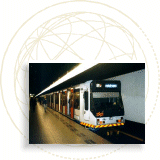home | nieuws | projecten | www-links | bibliotheek | vraag het RCM
Amsterdam - GVB Crime and insecurity The results of a GVB company survey held in 1994 gives insight into the degree that passengers, non-passengers, and personnel consider the public transportation in Amsterdam (metro, tram, bus, and ferry) to be (un)safe and the extent in which they have actually been a victim of crime while using public transportation. This survey showed that 24% of the interviewed passengers had actually been a victim of incidents within Amsterdam public transportation. Within the Amsterdam Metro, the rate of victimisation among passengers was even bigger (38%). The biggest part of this percentage (27%) was made up of cases of harassment. More serious criminal offenses fortunately happened less frequently: 2% of the passengers had been victims of violence against the person, 9% reported to have been threatened, and 6% had been victims of thefts. The personnel of the Amsterdam Metro had, however, considerable higher rates of victimisation: 77% reported to have been harassed during the past 12 months, 14% had been victims of violence, 64% had been threatened, and 7% had been victims of thefts. Among the metro personnel, there was also a considerable degree of multiple victimisation, especially regarding harassment and threat. Much more than in any other means of public transportation, passengers felt unsafe within the metro stations (28%) and trains (20%). When asked for the reasons for these feelings of insecurity, passengers referred to the high presence of junkies, vagrants, and drunks in the stations and trains. The absence of sufficient social control was also mentioned as an important cause for feelings of unsafety. More than 70% of the metro personnel reported that they sometimes (57%) or frequently (14%) felt unsafe within the metro system. These percentages are much higher than among the personnel of Amsterdam trams (39%) or buses (50%). |
|||||||
|
|||||||
Source: López, M.J.J., Crime Prevention Guidelines for the Construction & Management of Metro Systems, Den Haag: RCM-advies 1996, pg. 30-32. |

 The atmosphere and criminological situation within the present
Amsterdam Metro is a direct result of the political climate of
Amsterdam during the second half of the 1960's and the first half
of the 1970's. The East Line, which opened its doors in 1977,
is clearly designed according to the architectural principles
of the 'New Amsterdam School' (Brutalism) and organised on ideas
which emphasise 'personal freedom' and 'personal responsibility'.
Although very much in line with the ideas and 'low crime' situation
of the 1970's, the construction and organisation of the metro
did not prove resistant to the (negative) consequences of rapid
increasing crime rates and changing values. The system of open
access through which everybody could enter and leave at will,
did not prove resistant to general abuse and strongly contributed
to a high degree of fare evasion. In 1993, the rate of fare evasion
within the Amsterdam Metro reached a height of 20%. The increasing
presence of dealing and weaning drug addicts, vagrants, and disorderly
youngsters in the city of Amsterdam also had its clear repercussions
on the public safety within the metro system. The high accessibility,
shabby interior design, absence of (palpable and motivated) social
control, high number of niches and unsurveillable corners within
the metro system provided ample opportunity for these groups to
hang around and contribute strongly to the objective and subjective
unsafety of the metro system. Vandalism, graffiti, drug abuse,
and pollution became omnipresent in the Amsterdam Metro and had
serious repercussions on the feelings for unsafety of both the
passengers and the metro personnel.
The atmosphere and criminological situation within the present
Amsterdam Metro is a direct result of the political climate of
Amsterdam during the second half of the 1960's and the first half
of the 1970's. The East Line, which opened its doors in 1977,
is clearly designed according to the architectural principles
of the 'New Amsterdam School' (Brutalism) and organised on ideas
which emphasise 'personal freedom' and 'personal responsibility'.
Although very much in line with the ideas and 'low crime' situation
of the 1970's, the construction and organisation of the metro
did not prove resistant to the (negative) consequences of rapid
increasing crime rates and changing values. The system of open
access through which everybody could enter and leave at will,
did not prove resistant to general abuse and strongly contributed
to a high degree of fare evasion. In 1993, the rate of fare evasion
within the Amsterdam Metro reached a height of 20%. The increasing
presence of dealing and weaning drug addicts, vagrants, and disorderly
youngsters in the city of Amsterdam also had its clear repercussions
on the public safety within the metro system. The high accessibility,
shabby interior design, absence of (palpable and motivated) social
control, high number of niches and unsurveillable corners within
the metro system provided ample opportunity for these groups to
hang around and contribute strongly to the objective and subjective
unsafety of the metro system. Vandalism, graffiti, drug abuse,
and pollution became omnipresent in the Amsterdam Metro and had
serious repercussions on the feelings for unsafety of both the
passengers and the metro personnel. Order
this book
Order
this book